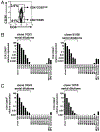Human tumor antigen-specific helper and regulatory T cells share common epitope specificity but exhibit distinct T cell repertoire
- PMID: 20483736
- PMCID: PMC7382897
- DOI: 10.4049/jimmunol.0903612
Human tumor antigen-specific helper and regulatory T cells share common epitope specificity but exhibit distinct T cell repertoire
Abstract
CD4(+) regulatory T cells (Tregs) accumulate at tumor sites and play a critical role in the suppression of immune responses against tumor cells. In this study, we show that two immunodominant epitopes derived from the tumor Ags (TAs) NY-ESO-1 and TRAG-3 stimulate both CD4+ Th cells and Tregs. TA-specific Tregs inhibit the proliferation of allogenic T cells, act in a cell-to-cell contact dependent fashion and require activation to suppress IL-2 secretion by T cells. TRAG-3 and NY-ESO-1-specific Tregs exhibit either a Th1-, a Th2-, or a Th0-type cytokine profile and dot not produce IL-10 or TGF-beta. The Foxp3 levels vary from one Treg clone to another and are significantly lower than those of CD4+CD25high Tregs. In contrast to NY-ESO-1-specific Th cells, the NY-ESO-1-specific and TRAG-3-specific Treg clonotypes share a common TCR CDR3 Vbeta usage with Foxp3+CD4+CD25high and CD4+CD25- T cells and were not detectable in PBLs of other melanoma patients and of healthy donors, suggesting that their recruitment occurs through the peripheral conversion of CD4+CD25- T cells upon chronic Ag exposure. Collectively, our findings demonstrate that the same epitopes spontaneously stimulate both Th cells and Tregs in patients with advanced melanoma. They also suggest that TA-specific Treg expansion may be better impaired by therapies aimed at depleting CD4+CD25high Tregs and preventing the peripheral conversion of CD4+CD25- T cells.
Conflict of interest statement
Disclosures
The authors have no financial conflicts of interest.
Figures







Similar articles
-
Epitope hierarchy of spontaneous CD4+ T cell responses to LAGE-1.J Immunol. 2011 Jan 1;186(1):312-22. doi: 10.4049/jimmunol.1001989. Epub 2010 Dec 3. J Immunol. 2011. PMID: 21131422 Free PMC article.
-
Induction of regulatory T cell-resistant helper CD4+ T cells by bacterial vector.Blood. 2008 Feb 1;111(3):1404-12. doi: 10.1182/blood-2007-09-113761. Epub 2007 Nov 6. Blood. 2008. PMID: 17986662
-
One NY-ESO-1-derived epitope that promiscuously binds to multiple HLA-DR and HLA-DP4 molecules and stimulates autologous CD4+ T cells from patients with NY-ESO-1-expressing melanoma.J Immunol. 2005 Feb 1;174(3):1751-9. doi: 10.4049/jimmunol.174.3.1751. J Immunol. 2005. PMID: 15661941
-
Regulatory T cell migration during an immune response.Trends Immunol. 2012 Apr;33(4):174-80. doi: 10.1016/j.it.2012.01.002. Epub 2012 Feb 2. Trends Immunol. 2012. PMID: 22305714 Free PMC article. Review.
-
Peptide epitope identification for tumor-reactive CD4 T cells.Curr Opin Immunol. 2008 Apr;20(2):221-7. doi: 10.1016/j.coi.2008.04.011. Epub 2008 May 20. Curr Opin Immunol. 2008. PMID: 18499419 Free PMC article. Review.
Cited by
-
MELOE-1 antigen contains multiple HLA class II T cell epitopes recognized by Th1 CD4+ T cells from melanoma patients.PLoS One. 2012;7(12):e51716. doi: 10.1371/journal.pone.0051716. Epub 2012 Dec 20. PLoS One. 2012. PMID: 23284752 Free PMC article.
-
PD-1 and Tim-3 regulate the expansion of tumor antigen-specific CD8⁺ T cells induced by melanoma vaccines.Cancer Res. 2014 Feb 15;74(4):1045-55. doi: 10.1158/0008-5472.CAN-13-2908. Epub 2013 Dec 16. Cancer Res. 2014. PMID: 24343228 Free PMC article. Clinical Trial.
-
The opposing roles of CD4+ T cells in anti-tumour immunity.Immunology. 2018 Apr 27;154(4):582-92. doi: 10.1111/imm.12941. Online ahead of print. Immunology. 2018. PMID: 29700809 Free PMC article. Review.
-
Revolutionizing cancer care strategies: immunotherapy, gene therapy, and molecular targeted therapy.Mol Biol Rep. 2024 Jan 28;51(1):219. doi: 10.1007/s11033-023-09096-8. Mol Biol Rep. 2024. PMID: 38281269 Free PMC article. Review.
-
Epitope hierarchy of spontaneous CD4+ T cell responses to LAGE-1.J Immunol. 2011 Jan 1;186(1):312-22. doi: 10.4049/jimmunol.1001989. Epub 2010 Dec 3. J Immunol. 2011. PMID: 21131422 Free PMC article.
References
-
- Boon T, Cerottini JC, Van den Eynde B, van der Bruggen P, and Van Pel A. 1994. Tumor antigens recognized by T lymphocytes. Annu. Rev. Immunol 12: 337–365. - PubMed
-
- Rosenberg SA, Sherry RM, Morton KE, Scharfman WJ, Yang JC, Topalian SL, Royal RE, Kammula U, Restifo NP, Hughes MS, et al. 2005. Tumor progression can occur despite the induction of very high levels of self/tumor antigen-specific CD8+ T cells in patients with melanoma. J. Immunol 175: 6169–6176. - PubMed
-
- Marincola FM, Jaffee EM, Hicklin DJ, and Ferrone S. 2000. Escape of human solid tumors from T-cell recognition: molecular mechanisms and functional significance. Adv. Immunol 74: 181–273. - PubMed
-
- Sakaguchi S 2004. Naturally arising CD4+ regulatory t cells for immunologic self-tolerance and negative control of immune responses. Annu. Rev. Immunol 22: 531–562. - PubMed
-
- Shevach EM 2002. CD4+ CD25+ suppressor T cells: more questions than answers. Nat. Rev. Immunol 2: 389–400. - PubMed
Publication types
MeSH terms
Substances
Grants and funding
LinkOut - more resources
Full Text Sources
Other Literature Sources
Research Materials

